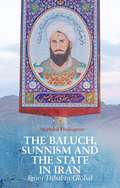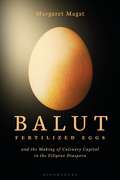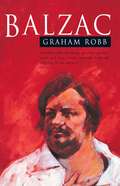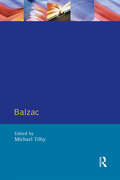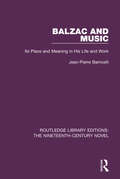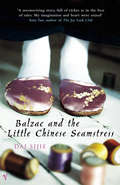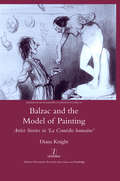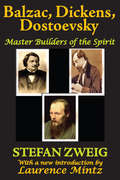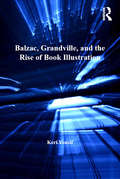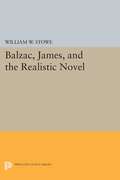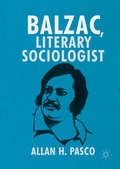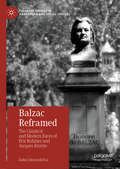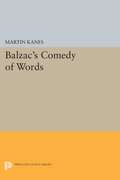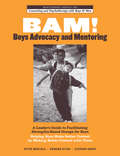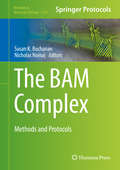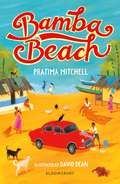- Table View
- List View
The Baluch, Sunnism and the State in Iran: From Tribal to Global
by Stéphane A. DudoignonThis fascinating study explores the emergence of a significant Sunni community on the margins of Shia Iran and delineates a 'Sunni arc' stretching from Central Asia southwards through the Iranian provinces of Khorasan and Baluchistan.
The Baluch, Sunnism and the State in Iran: From Tribal to Global
by Stéphane A. DudoignonThis fascinating study explores the emergence of a significant Sunni community on the margins of Shia Iran and delineates a 'Sunni arc' stretching from Central Asia southwards through the Iranian provinces of Khorasan and Baluchistan.
Balut: Fertilized Eggs and the Making of Culinary Capital in the Filipino Diaspora
by Margaret MagatIn this book, Margaret Magat explores both the traditional and popular culture contexts of eating balut. Balut-fertilized duck or chicken eggs that have developed into fully formed embryos with feathers and beaks-is a delicacy which elicits passionate responses. Hailed as an aphrodisiac in Filipino culture, balut is often seen and used as an object of revulsion in Western popular culture. Drawing on interviews, participant observation, reality television programs, travel shows, food blogs, and balut-eating contests, Magat examines balut production and consumption, its role in drinking rituals, sex, and also the vampire-like legends behind it. Balut reveals how traditional foods are used in the performance of identity and ethnicity, inspiring a virtual online cottage industry via social media. It also looks at the impact globalization and migration are having on cultural practices and food consumption across the world. The first academic book on balut, this is essential reading for anyone in food studies, folklore studies, anthropology, and Asian American studies.
Balut: Fertilized Eggs and the Making of Culinary Capital in the Filipino Diaspora
by Margaret MagatIn this book, Margaret Magat explores both the traditional and popular culture contexts of eating balut. Balut-fertilized duck or chicken eggs that have developed into fully formed embryos with feathers and beaks-is a delicacy which elicits passionate responses. Hailed as an aphrodisiac in Filipino culture, balut is often seen and used as an object of revulsion in Western popular culture. Drawing on interviews, participant observation, reality television programs, travel shows, food blogs, and balut-eating contests, Magat examines balut production and consumption, its role in drinking rituals, sex, and also the vampire-like legends behind it. Balut reveals how traditional foods are used in the performance of identity and ethnicity, inspiring a virtual online cottage industry via social media. It also looks at the impact globalization and migration are having on cultural practices and food consumption across the world. The first academic book on balut, this is essential reading for anyone in food studies, folklore studies, anthropology, and Asian American studies.
Balzac
by Graham RobbGraham Robb has produced a masterpiece literary biography in which Balzac bursts into life on every page. The living manifestation of the colourful and varied world he described, yet at the same time its most astonishing exception, Balzac is the perfect subject for biography. Robb skilfully interweaves the life with the work to paint an indelible and brilliantly compelling portrait of one of the great tragicomic heroes of the nineteenth century, a man whose influence both in and outside his native France has been and is still immense.
Balzac (Modern Literatures In Perspective)
by Michael TilbyThis canon of French literature, Honore de Balzac (1799-1850) is also a major European figure in the development of realism. His work is dominated by an inter-related sequence of novels and short stories, La Comedie Humanine, which charts the idiosyncrasies of French society from the beginning of the nineteenth century to the 1840's. Among the most famous of these are Le Pierre Goriot and La Cousine Bette. Iin this study, Dr Tilby concentrates on the main approaches in practice and discusses some of the earliest responses to Balzac's work. His introduction and headnotes set Balzac's work in context. This book will be of interest to students of French language and literature and also to those studying French in combined studies or humanities courses.
Balzac (Modern Literatures In Perspective)
by Michael TilbyThis canon of French literature, Honore de Balzac (1799-1850) is also a major European figure in the development of realism. His work is dominated by an inter-related sequence of novels and short stories, La Comedie Humanine, which charts the idiosyncrasies of French society from the beginning of the nineteenth century to the 1840's. Among the most famous of these are Le Pierre Goriot and La Cousine Bette. Iin this study, Dr Tilby concentrates on the main approaches in practice and discusses some of the earliest responses to Balzac's work. His introduction and headnotes set Balzac's work in context. This book will be of interest to students of French language and literature and also to those studying French in combined studies or humanities courses.
Balzac and Music: Its Place and Meaning in His Life and Work (Routledge Library Editions: The Nineteenth-Century Novel)
by Jean-Pierre BarricelliFirst published in 1990, this book was the first comprehensive study of Balzac’s relationship to music, blending past scholarship with new perspectives to formulate an inclusive account. It begins by examining the contacts and experiences that shaped the musical side of Balzac’s life. These left valuable and lasting impressions which often found their way into his writings, where he recorded a myriad of critical and musicological opinions — assessed primarily in relation to Gambara and Massimilla Doni. These discussions prepare the way for an analysis of Balzac two major musical persuasions: religious music and Beethoven. This book will be of interest to students of literature and music.
Balzac and Music: Its Place and Meaning in His Life and Work (Routledge Library Editions: The Nineteenth-Century Novel)
by Jean-Pierre BarricelliFirst published in 1990, this book was the first comprehensive study of Balzac’s relationship to music, blending past scholarship with new perspectives to formulate an inclusive account. It begins by examining the contacts and experiences that shaped the musical side of Balzac’s life. These left valuable and lasting impressions which often found their way into his writings, where he recorded a myriad of critical and musicological opinions — assessed primarily in relation to Gambara and Massimilla Doni. These discussions prepare the way for an analysis of Balzac two major musical persuasions: religious music and Beethoven. This book will be of interest to students of literature and music.
Balzac and the Little Chinese Seamstress
by Dai Sijie1971: Mao's cultural Revolution is at its peak. Two sons of doctors, sent to 're-education' camps, forced to carry buckets of excrement up and down mountain paths, have only their sense of humour to keep them going. Although the attractive daughter of the local tailor also helps to distract them from the task at hand. The boys' true re-education starts, however, when they discover a hidden suitcase packed with the great Western novels of the nineteenth century. Their lives are transformed. And not only their lives: after listening to the stories of Balzac, the little seamstress will never be the same again.
Balzac and the Model of Painting: Artist Stories in La Comedie Humaine
by Diana Knight"Texts about paintings, painters and sculptors are obvious test cases for issues of representation. A significant corpus of artist stories is scattered through Honore de Balzac's Comedie humaine which, from Marx to Lukacs to Roland Barthes's enormously influential S/Z (1970), has been a key literary work for critical debates around French realism. In a series of close readings, Diana Knight explores Barthes's 'model of painting' - the metaphorical code of painting and sculpture that underpins realist discourse - in the context of Balzac's fictional representations of the relation between artists, their models and their works of art. Whereas critics have tended to denounce Balzac's realist aesthetic as complicit with the misogyny of the society he portrays,Balzac and the Model of Painting takes the artist-model relationship, variously gendered in these stories, as the focus of the author's powerful realist critique of the sexual politics of prostitution and marriage in nineteenth-century France."
Balzac and the Model of Painting: Artist Stories in La Comedie Humaine
by Diana Knight"Texts about paintings, painters and sculptors are obvious test cases for issues of representation. A significant corpus of artist stories is scattered through Honore de Balzac's Comedie humaine which, from Marx to Lukacs to Roland Barthes's enormously influential S/Z (1970), has been a key literary work for critical debates around French realism. In a series of close readings, Diana Knight explores Barthes's 'model of painting' - the metaphorical code of painting and sculpture that underpins realist discourse - in the context of Balzac's fictional representations of the relation between artists, their models and their works of art. Whereas critics have tended to denounce Balzac's realist aesthetic as complicit with the misogyny of the society he portrays,Balzac and the Model of Painting takes the artist-model relationship, variously gendered in these stories, as the focus of the author's powerful realist critique of the sexual politics of prostitution and marriage in nineteenth-century France."
Balzac, Dickens, Dostoevsky: Master Builders of the Spirit
by Stefan ZweigWritten over a period of twenty-five years, this first volume in a trilogy is intended to depict in the life and work of writers of different nationalities--Balzac, Dickens, and Dostoevsky--the world-portraying novelist. Though these essays were composed at fairly long intervals, their essential uniformity has prompted Zweig to bring these three great novelists of the nineteenth century together; to show them as writers who, for the very reason that they contrast with each other, also complete one another in ways which makes them round our concept of the epic portrayers of the world.Zweig considers Balzac, Dickens, and Dostoevsky the supremely great novelists of the nineteenth century. He draws between the writer of one outstanding novel, and what he terms a true novelist--an epic master, the creator of an almost unending series of pre-eminent romances. The novelist in this higher sense is endowed with encyclopedic genius, is a universal artist, who constructs a cosmos, peopling it with types of his own making, giving it laws of gravity that are unique to these fi gures.Each of the novelists featured in Zweig's book has created his own sphere: Balzac, the world of society; Dickens, the world of the family; Dostoevsky, the world of the One and of the All. A comparison of these spheres serves to prove their diff erences. Zweig does not put a valuation on the differences, or emphasize the national element in the artist, whether in a spirit of sympathy or antipathy. Every great creator is a unity in himself, with its own boundaries and specifi c gravity. There is only one specifi c gravity possible within a single work, and no absolute criterion in the sales of justice. This is the measure of Zweig, and the message of this book.
Balzac, Dickens, Dostoevsky: Master Builders of the Spirit
by Stefan ZweigWritten over a period of twenty-five years, this first volume in a trilogy is intended to depict in the life and work of writers of different nationalities--Balzac, Dickens, and Dostoevsky--the world-portraying novelist. Though these essays were composed at fairly long intervals, their essential uniformity has prompted Zweig to bring these three great novelists of the nineteenth century together; to show them as writers who, for the very reason that they contrast with each other, also complete one another in ways which makes them round our concept of the epic portrayers of the world.Zweig considers Balzac, Dickens, and Dostoevsky the supremely great novelists of the nineteenth century. He draws between the writer of one outstanding novel, and what he terms a true novelist--an epic master, the creator of an almost unending series of pre-eminent romances. The novelist in this higher sense is endowed with encyclopedic genius, is a universal artist, who constructs a cosmos, peopling it with types of his own making, giving it laws of gravity that are unique to these fi gures.Each of the novelists featured in Zweig's book has created his own sphere: Balzac, the world of society; Dickens, the world of the family; Dostoevsky, the world of the One and of the All. A comparison of these spheres serves to prove their diff erences. Zweig does not put a valuation on the differences, or emphasize the national element in the artist, whether in a spirit of sympathy or antipathy. Every great creator is a unity in himself, with its own boundaries and specifi c gravity. There is only one specifi c gravity possible within a single work, and no absolute criterion in the sales of justice. This is the measure of Zweig, and the message of this book.
Balzac, Grandville, and the Rise of Book Illustration
by Keri YousifExamining how the rise of book illustration affected the historic hegemony of the word, Keri Yousif explores the complex literary and artistic relationship between the novelist Honoré de Balzac and the illustrator J. J. Grandville during the French July Monarchy (1830-1848). Both collaborators and rivals, these towering figures struggled for dominance in the Parisian book trade at the height of the Romantic revolution and its immediate aftermath. Both men were social portraitists who collaborated on the influential encyclopedic portrayal of nineteenth-century society, Les Français peints par eux-mêmes. However, their collaboration soon turned competitive with Grandville's publication of Scènes de la vie privée et publique des animaux, a visual parody of Balzac's Scènes de la vie privée. Yousif investigates Balzac's and Grandville's individual and joint artistic productions in terms of the larger economic and aesthetic struggles within the nineteenth-century arena of cultural production, showing how writers were forced to position themselves both in terms of the established literary hierarchy and in relation to the rapidly advancing image. As Yousif shows, the industrialization of the illustrated book spawned a triadic relationship between publisher, writer, and illustrator that transformed the book from a product of individual genius to a cooperative and commercial affair. Her study represents a significant contribution to our understanding of literature, art, and their interactions in a new marketplace for publication during the fraught transition from Romanticism to Realism.
Balzac, Grandville, and the Rise of Book Illustration
by Keri YousifExamining how the rise of book illustration affected the historic hegemony of the word, Keri Yousif explores the complex literary and artistic relationship between the novelist Honoré de Balzac and the illustrator J. J. Grandville during the French July Monarchy (1830-1848). Both collaborators and rivals, these towering figures struggled for dominance in the Parisian book trade at the height of the Romantic revolution and its immediate aftermath. Both men were social portraitists who collaborated on the influential encyclopedic portrayal of nineteenth-century society, Les Français peints par eux-mêmes. However, their collaboration soon turned competitive with Grandville's publication of Scènes de la vie privée et publique des animaux, a visual parody of Balzac's Scènes de la vie privée. Yousif investigates Balzac's and Grandville's individual and joint artistic productions in terms of the larger economic and aesthetic struggles within the nineteenth-century arena of cultural production, showing how writers were forced to position themselves both in terms of the established literary hierarchy and in relation to the rapidly advancing image. As Yousif shows, the industrialization of the illustrated book spawned a triadic relationship between publisher, writer, and illustrator that transformed the book from a product of individual genius to a cooperative and commercial affair. Her study represents a significant contribution to our understanding of literature, art, and their interactions in a new marketplace for publication during the fraught transition from Romanticism to Realism.
Balzac, James, and the Realistic Novel (PDF)
by William W. StoweThis book has a double purpose: to compare the literary projects, theories, and careers of Balzac and Henry James, and to develop a theory of realism that can account for their unabashed mimetic intentions and for their novels' sophisticated textuality.Originally published in 1983.The Princeton Legacy Library uses the latest print-on-demand technology to again make available previously out-of-print books from the distinguished backlist of Princeton University Press. These editions preserve the original texts of these important books while presenting them in durable paperback and hardcover editions. The goal of the Princeton Legacy Library is to vastly increase access to the rich scholarly heritage found in the thousands of books published by Princeton University Press since its founding in 1905.
Balzac, Literary Sociologist
by Allan H. PascoMelding the fields of literature, sociology, and history, this book develops analyses of the ten novels in Balzac's Scènes de la vie de province. Following the order of the novels projected in La Comédie humaine, Allan H. Pasco investigates how Balzac used art as a tool of social inquiry to obtain startlingly accurate insights into the relationships that defined his turbulent society. His repeated claim to be an "historian of manners" was more than an empty boast. Though Balzac was first and foremost a great novelist, he was also a trailblazing sociologist, joining Henri de Saint-Simon and the subsequent Auguste Comte in considering the relationships that represent society as an interacting, interlocking web. Using a methodology that combines close analysis with a broad cultural context, Pasco demonstrates that Balzac's sociological vision was extraordinarily pertinent to both his and our days.
Balzac Reframed: The Classical and Modern Faces of Éric Rohmer and Jacques Rivette (Palgrave Studies in Adaptation and Visual Culture)
by Zahra Tavassoli ZeaThis book examines the theoretical affiliations between the most notable proponent of literary realism, Honoré de Balzac, and two understated but key representatives of the French New Wave, Éric Rohmer and Jacques Rivette. It argues that their film criticism, which gradually led to the establishment of a common aesthetic vision of cinema (the “politique des auteurs”), owes more to Balzac and the nineteenth-century novel than to any intellectual trend of the immediate post-war period. By considering the films of Rohmer and Rivette as an extension of their writings (essays, film reviews, scriptwriting, novels and interviews), this volume analyses the changing and sometimes opposed ways in which they applied Balzacian principles and themes to their cinematic practice. Essentially, it understands the exchange between art forms, past traditions and contemporaneous currents as the overlooked yet common thread that links these three authors, through their own re-appropriations of classical and romantic aesthetics in their explorations of modern French society. In doing so, this study provides further nuance to the “conservative” versus “progressist” rupture that is generally assumed between the two directors, and offers an innovative reading of The Human Comedy in the light of post-war ideas on authorship, film adaptation, classicism and modernism.
Balzac's Comedy of Words (PDF)
by Martin KanesAlthough Balzac's work has been much studied, practically nothing has been written on his use of linguistic concepts. Applying a new approach, this perceptive book demonstrates that the theme and theory of language were central to Balzac's fiction. In considering how the novelist was influenced by eighteenth- and nineteenth-century speculation on language, Martin Kanes traces the development of Balzac's own linguistic ideas from his early to his later writings.Originally published in 1976.The Princeton Legacy Library uses the latest print-on-demand technology to again make available previously out-of-print books from the distinguished backlist of Princeton University Press. These editions preserve the original texts of these important books while presenting them in durable paperback and hardcover editions. The goal of the Princeton Legacy Library is to vastly increase access to the rich scholarly heritage found in the thousands of books published by Princeton University Press since its founding in 1905.
BAM! Boys Advocacy and Mentoring: A Leader’s Guide to Facilitating Strengths-Based Groups for Boys - Helping Boys Make Better Contact by Making Better Contact with Them (The Routledge Series on Counseling and Psychotherapy with Boys and Men #Vol. 2)
by Peter Mortola Howard Hiton Stephen GrantOver the past decade, our understanding of the fundamental differences in child development, behavior, and emotional maturity between boys and girls has increased dramatically, and as a result, many gender-specific interventions and support programs have been developed to meet the needs of parents, teachers, and mental health professionals. However, these all take the form of responses designed to minimize an already disruptive behavior pattern. What has been needed is a pro-active program whose goal is to instill positive skills and patterns in 'at-risk' boys, rather than waiting to address problems after they are already visible. The BAM! Boys Advocacy and Mentoring program fills this need by providing the first guidebook for group facilitators who want to lead preventative boys groups designed to foster communication skills and emotional connections. Based on years of research and refined over the course of countless sessions run by the authors, the program has been field-tested and tailored for use either in the school setting or outside. Over a series of group sessions, participants are encouraged to understand their emotions and interpersonal interactions without losing a sense of 'maleness' as a result of emotional growth and communication with peers about personal issues. The activities are designed to be engaging across age groups, and the individual exercises and program structure can be modified to fit into any existing school- or community-based mentoring system. The guidebook contains all of the information and tools a facilitator needs in order to implement and maintain these boys groups.
BAM! Boys Advocacy and Mentoring: A Leader’s Guide to Facilitating Strengths-Based Groups for Boys - Helping Boys Make Better Contact by Making Better Contact with Them (The Routledge Series on Counseling and Psychotherapy with Boys and Men)
by Peter Mortola Howard Hiton Stephen GrantOver the past decade, our understanding of the fundamental differences in child development, behavior, and emotional maturity between boys and girls has increased dramatically, and as a result, many gender-specific interventions and support programs have been developed to meet the needs of parents, teachers, and mental health professionals. However, these all take the form of responses designed to minimize an already disruptive behavior pattern. What has been needed is a pro-active program whose goal is to instill positive skills and patterns in 'at-risk' boys, rather than waiting to address problems after they are already visible. The BAM! Boys Advocacy and Mentoring program fills this need by providing the first guidebook for group facilitators who want to lead preventative boys groups designed to foster communication skills and emotional connections. Based on years of research and refined over the course of countless sessions run by the authors, the program has been field-tested and tailored for use either in the school setting or outside. Over a series of group sessions, participants are encouraged to understand their emotions and interpersonal interactions without losing a sense of 'maleness' as a result of emotional growth and communication with peers about personal issues. The activities are designed to be engaging across age groups, and the individual exercises and program structure can be modified to fit into any existing school- or community-based mentoring system. The guidebook contains all of the information and tools a facilitator needs in order to implement and maintain these boys groups.
The BAM Complex: Methods and Protocols (Methods in Molecular Biology #1329)
by Susan K. Buchanan and Nicholas NoinajThis volume is comprised of a collection of experimental protocols for common techniques and strategies used to study the biogenesis of b-barrel outer membrane proteins in Gram-negative bacteria. The BAM Complex: Methods and Protocols guides readers through methods on the function of the BAM complex, the roles played by each of the individual components, the expression and purification of the components, crystallization and structure determination of the components, and how the individual Bam components may assemble into a functional complex. Written in the highly successful Methods in Molecular Biology series format, chapters include introductions to their respective topics, lists of the necessary materials and reagents, step-by-step, readily reproducible laboratory protocols, and tips on troubleshooting and avoiding known pitfalls.Authoritative and cutting-edge, The BAM Complex: Methods and Protocols will serve as an invaluable reference for those interested in studying the BAM complex.
Bamba Beach: A Bloomsbury Reader (Bloomsbury Readers)
by Pratima MitchellA poignant, contemporary family story set in Goa, India, written by Pratima Mitchell.Hari's family make their living from fishing, but with no fish left in the bay, times are really hard. To catch the fish further away they need a better boat, but to get a better boat they need to sell fish… Despite family feuds and village superstitions standing in his way, Hari doesn't give up, and it isn't long before help arrives from the most unlikely source. This thought-provoking story from Pratima Mitchell has engaging black-and-white illustrations by David Dean and is perfect for children who are developing as readers.The Bloomsbury Readers series is packed with brilliant books to get children reading independently in Key Stage 2, with book-banded stories by award-winning authors like double Carnegie Medal winner Geraldine McCaughrean and Waterstones Prize winner Patrice Lawrence covering a wide range of genres and topics. With charming illustrations, ideas for discussion points and online guided reading notes written by the Centre for Literacy in Primary Education (CLPE), this series is ideal for reading both in the classroom and at home. For more information visit www.bloomsburyguidedreading.com.'Patrice Lawrence, Tony Bradman, Margaret Mahy [...] any list that brings together such a quality line up of authors is going to be welcomed.' - Books for Keeps on the seriesBook Band: Dark Blue (Ideal for ages 9+)
